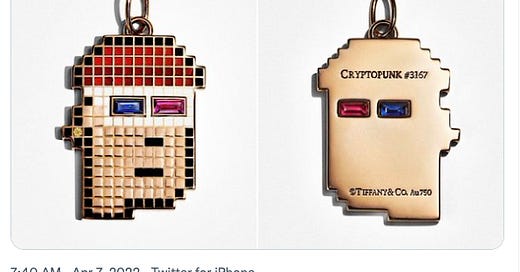Shall I weigh in on the CryptoPunks Tiffany’s tie-up?
What to do if you want degens to buy engagement rings? A case study.
Tl;dr if you’re in the business of selling engagement rings to young men, pulling off a kooky stunt targeting web3 fanatics (mostly, if not exclusively, men), rich with .eth who may not see your traditional marketing is not a shabby idea.
I’m sure you’ve all seen the news; thanks to Arnault Jr.’s interest in NFTs and personal ownership of a CryptoPunk (an OG NFT project of, well, cryptopunks), Tiffany’s, a storied luxury jewelry brand that is currently doing a yeoman’s job of reinventing themselves to compete with Van Cleef and Arpel and Cartier, decided to launch high-end pendant versions of the CryptoPunks imagery for holders of the NFT. (yes, that was one hell of a run on)
One of the THINGS about NFT projects is that purchase often comes with IP rights. I buy a Bored Ape, I make a Bored Ape T-Shirt, TV show, or restaurant, and I can profit from the (possibly somewhat niche) popularity of the brand. This IP ownership is why people say these projects will/could/should be the next Marvel Universes. Power to the people! CryptoPunks were actually late to this game, and only in March, when Bored Ape Yacht Club owner Yuga Labs acquired them, were holders granted commercial rights.
But the Tiffany project is a bit different. I take my Cryptopunk and effectively commission a precious-jewels version of it. From Vogue Business, “From 5-12 August, owners of Cryptopunk NFT profile pictures can order an “NFTiff Pass” for ETH 30 (about $52,000 as of 28 July) on a new website that connects to their digital wallets, purchased only with Ethereum. Tiffany designers will interpret each Cryptopunk into a custom-designed pendant, available only to those with the NFTiff pass.”
Like so many NFT projects, the Twitter following seems to be the real predictor of commercial success.
What if, say, a hundred years ago, I, too, had massive wealth from something speculative and novel, IDK, shorting the stock market, and I went and commissioned something from Tiffany’s by artist Jean Schlumberger? Comme ci.
Now, I don’t own the rights to this piece of jewelry, and I cannot make copies and sell them to others who are into this stunning piece. But I can resell to an interested buyer.
Contrast with my Cryptopunk. Can I make copies of the Tiffany’s Cryptopunk necklace? I own the IP of my punk, not of the artistic derivative of my punk. And why could I not have simply commissioned this from any old jeweler? What does Tiffany’s bring to the game? Surely some technical know-how but nothing that seems market-defining. Arnault’s Twitter followers? There was a brouhaha on Twitter over the Ts and C’s (to be fair, it’s only a brouhaha bc it’s on Twitter, elsewhere, you just might call it investigative reporting).
Initially, the T’s and C’s, seemingly, allowed Tiffany’s to make as many of each Cryptopunk necklace as they wanted. This misstep has been rectified but is a funny kind of “counterfeit” to ponder. Imagine ordering a Cryptopunk from Tiffany’s for an NFT you didn’t own. I’m sure someone would.
On the other hand, speaking of “counterfeits,” the transaction is, of course, on the blockchain, so the “flex” is recorded for all to see. As opposed to the quite traditional flex of wearing a $50k necklace, which has to be in person or on Zoom to be visible. I hope G-Money’s luxury Web3 brand is selling V-Neck tee shirts, or the flex might be hard to pull off on Zoom. To close this thought out, I get it, it’s a little different than just commissioning your own. But also, in the decentralized thesis of Web3, the Cryptopunks owners just handed MASSIVE margin and marketing benefits to a big, old-fashioned conglomerate. Not exactly decentralized.
Then it hit me like a ton of bricks.
This is plain, old-fashioned, darned good marketing. Some financial background. Before their sale to LVMH, Tiffany’s revenue was about $4bn a year, and this has undoubtedly increased since the purchase, given the popularity of many of the new efforts. (LVMH does not break down earnings by company) In 2009 (the last data I could find), engagement rings were 16-21% of total sales. Generously extrapolating to today, that might be almost a billion dollars of engagement rings. Who buys engagement rings?
DEGENS! Ok, well, some of them. In that DEGENS are young men, some of whom are crypto rich and some of whom have girlfriends who will one day be fiancées.
If their primary business is selling diamond engagement rings for a massive markup, then anything Tiffany’s can do to reach and impress young men who are wealthy or aspiring to be wealthy is an excellent brand move.
Fin.
Did you find this valuable? Share with a friend!




